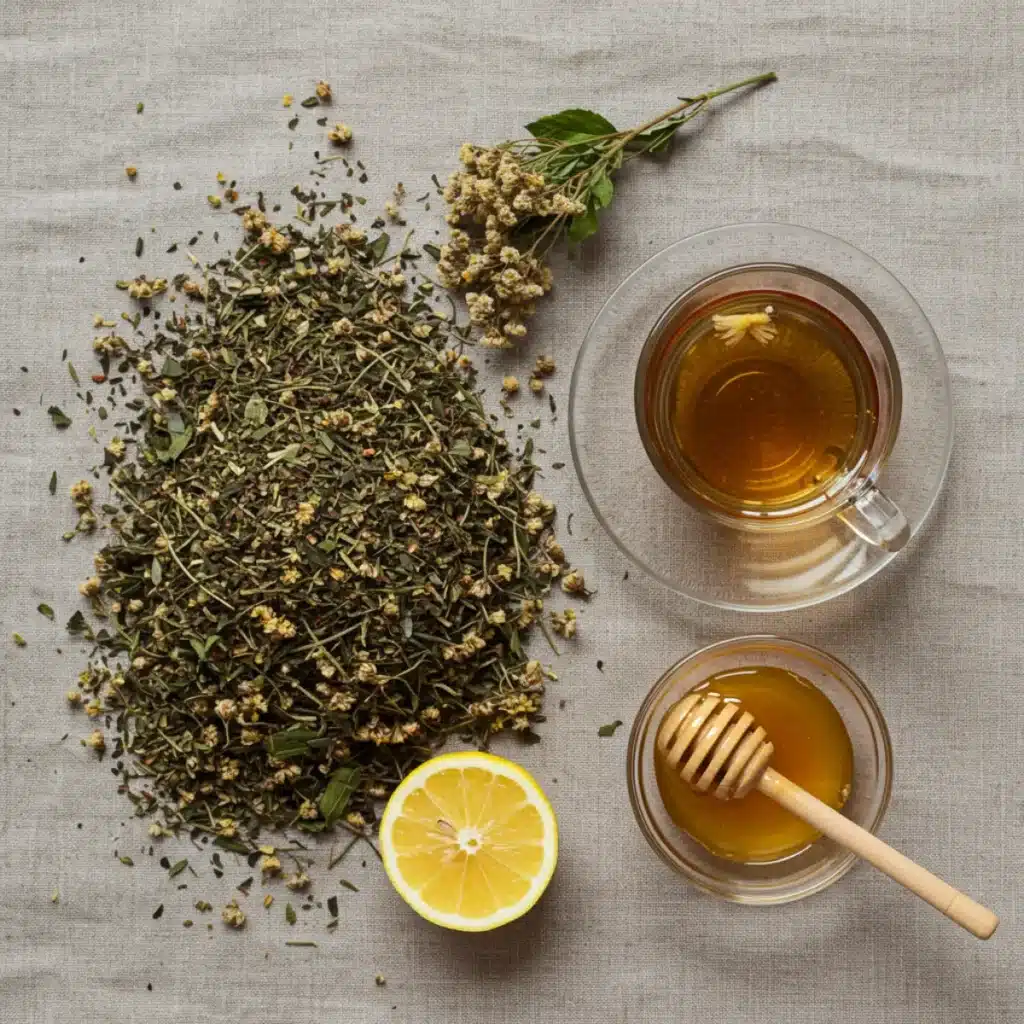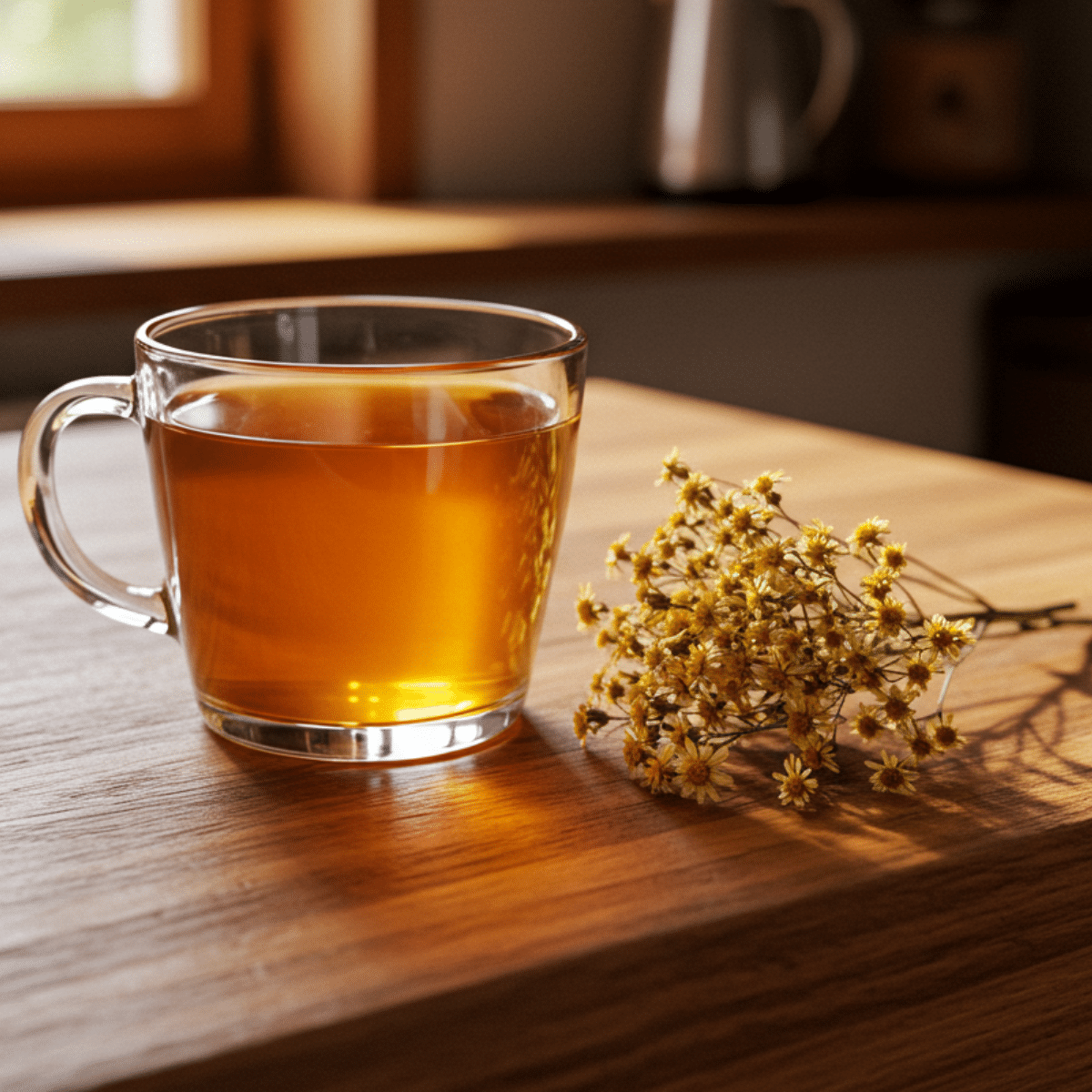Agrimony tea recipe is a timeless remedy rooted in herbal traditions and trusted for its gentle yet effective support. Agrimony tea recipe is one of those ancient herbal treasures that quietly holds a powerful place in natural wellness. I first came across agrimony during a trip to a tiny apothecary nestled in the Texas Hill Country. The earthy, slightly citrusy aroma immediately caught my attention. It wasn’t flashy—but it had presence. As I learned more, I discovered agrimony had long been prized for both its physical healing properties and its gentle spiritual support. This article will walk you through exactly how to make agrimony tea and why it deserves a spot in your home remedy toolkit.
Table of Contents
Agrimony Tea Recipe & Why It Matters
Why the agrimony tea recipe belongs in your wellness routine
If you’re searching for a calming, herbal brew with centuries of history behind it, the agrimony tea recipe is a gentle powerhouse worth knowing. This golden-hued infusion has long been respected in folk medicine for its ability to ease digestion, calm the nerves, and gently support the liver. My first encounter with this tea happened in an old herbal shop deep in the Texas Hill Country. The smell—earthy with a whisper of citrus—immediately drew me in.
The agrimony tea recipe quickly became a favorite in my home, especially during seasonal changes or when I need a calming reset. It’s not just another herbal drink—it’s a healing ritual that supports the body and soothes the spirit. In fact, agrimony was once called the “all-heal” plant in medieval texts, often used to help people recover from both physical and emotional wounds. Today, I keep a jar of dried agrimony next to my favorite blends like this lemon balm tea for a rotating ritual of support.
How to prepare an agrimony tea recipe that works
To make an effective agrimony tea recipe, use one teaspoon of dried agrimony per cup of boiling water. Cover and steep it for 10 minutes to draw out its healing oils. Then strain and sip slowly. You can enjoy it alone or pair it with recipes like my dandelion root tea for weight loss. Whether warm or iced, the flavor is gently bitter with hints of citrus and pine—comforting, simple, and grounding. When made intentionally, the agrimony tea recipe becomes more than a beverage—it’s a form of care in a cup.

Agrimony Tea Recipe
- Prep Time: 2 minutes
- Cook Time: 10 minutes
- Total Time: 12 minutes
- Yield: 1 cup
- Category: Herbal Tea
- Method: Steeping
- Cuisine: Natural Wellness
Description
A calming and cleansing herbal infusion made with dried agrimony. This tea offers both spiritual and physical support.
Ingredients
- 1 tsp dried agrimony
- 1 cup boiling water
- Optional: 1/2 tsp lemon balm or lavender
- Optional: 1 tsp raw honey or lemon slice
Instructions
- Boil 1 cup of water.
- Add 1 tsp of dried agrimony to a teacup.
- Pour boiling water over the herbs.
- Cover and steep for 10 minutes.
- Strain and serve warm or over ice.
Notes
- Use organically sourced dried agrimony for best results.
- Avoid if pregnant, nursing, or on blood-thinners.
- Store dried agrimony in an airtight jar in a cool, dark place.
Emotional Healing & Spiritual Uses of Agrimony Tea
The spiritual side of the agrimony tea recipe
There’s more to an agrimony tea recipe than its physical health benefits. Historically, agrimony has held sacred value in herbal traditions for its spiritual properties. In old European folk practices, agrimony was often used to protect against negative energy, promote peaceful sleep, and encourage emotional clarity. The act of preparing this tea has long been seen as a quiet ritual—a time to pause, reflect, and ground yourself.
In my own life, I turn to the agrimony tea recipe when I’m feeling emotionally scattered or drained. It’s not about fixing anything—it’s about gently creating space to reconnect. The subtle bitterness of the tea seems to mirror the emotional work of letting go and clearing away what no longer serves you. That’s why I often drink it before meditation or yoga. It helps bring me into alignment, just like the guruko furidamo tea recipe that I also brew when I need clarity and calm.
Agrimony is believed to help those who hide inner turmoil behind a smile—making it especially powerful for highly sensitive people or those navigating stress quietly.
Emotional grounding in your daily ritual
What makes an agrimony tea recipe special is how it encourages mindfulness. The simple steps—boil, steep, sip—become a daily anchor. Just like my cortisol tea recipe, this tea invites you to slow down. Brew it with intention. Light a candle. Sit somewhere quiet. Let the aroma invite stillness. As the tea warms your body, it also creates space to breathe more deeply, think more clearly, and let your nervous system reset.
In today’s fast-paced world, finding calm in small daily rituals is more important than ever. An agrimony tea recipe does exactly that—offering both herbal relief and emotional nourishment in a single, soul-soothing cup.
Agrimony Tea Recipe Benefits for Body Wellness
Physical healing from the agrimony tea recipe
When it comes to gentle herbal remedies that support multiple systems in the body, the agrimony tea recipe stands out as both simple and effective. Traditionally used to treat digestive issues, sore throats, and minor skin conditions, agrimony’s tannins offer mild astringent properties that can calm inflammation and tighten tissues. For anyone dealing with bloating, sluggish digestion, or mild diarrhea, a warm cup of agrimony tea can feel like much-needed relief.
In my home, I often alternate this brew with my pumpkin seed tea recipe to support both digestive and urinary health naturally. What’s special about agrimony is that it doesn’t overpower your system—it works gently, encouraging the body to rebalance on its own terms. Rich in antioxidants like quercetin and luteolin, it may also help fight oxidative stress and protect tissues at a cellular level.
Many herbalists also turn to the agrimony tea recipe to help manage minor respiratory conditions, as its astringent nature can ease throat discomfort and dry up excess mucus. It’s a wonderful go-to during transitional seasons when the weather turns and colds start circulating.
Why it’s ideal for daily wellness support
If you’re looking for an herbal ally that can be safely enjoyed often, the agrimony tea recipe is an ideal option. Unlike stronger detox teas, it can be sipped regularly without taxing your system. Just like my chilis blackberry tea recipe, it’s the kind of tea you’ll want to keep in your weekly rotation for gentle ongoing care.
Agrimony supports the liver and gallbladder, making it useful for light internal cleansing, especially if your body feels sluggish or congested. You might even pair it with the dandelion root tea to create a balanced detox blend that works with your body, not against it.
A daily cup helps nurture wellness from the inside out—supporting immunity, aiding digestion, and creating a sense of calm presence throughout the day.
Agrimony Tea Recipe Blends for Targeted Herbal Support
Blending the agrimony tea recipe with complementary herbs
One of the things I love most about any agrimony tea recipe is how easily it plays well with others. Agrimony’s mildly bitter, slightly citrusy profile makes it an excellent base for herbal blends that support different systems in the body. Whether you’re aiming to improve digestion, soothe stress, or gently detox, agrimony acts as a supportive anchor in multi-herb infusions.
For digestive comfort, I often combine it with peppermint or fennel. When blended with calming herbs like lemon balm, it becomes a wonderfully grounding tea—perfect after a long day. You can see how beautifully that works in my lemon balm tea recipe, which shares similar calming effects and is a favorite before bedtime.
If you’re creating a stress-supporting blend, consider pairing agrimony with ashwagandha, oat straw, or lavender. The balance of grounding and uplifting tones in those herbs creates a cup that feels like a mini retreat—especially if you’re mentally overloaded.
Creating a custom agrimony tea recipe for your needs
Start with 1 tsp of dried agrimony per cup, then add half the amount of your secondary herbs. For example, if you want a relaxing blend, try adding ½ tsp dried lemon balm and ¼ tsp dried lavender to your agrimony base. Steep the blend for 10 minutes, covered, to preserve the oils. Strain and sip slowly.
If your goal is gentle detox, you might combine the agrimony tea recipe with dandelion root and nettle leaf for a supportive liver tonic. For something unique, consider exploring more herb-based options like my guruko furidamo tea recipe—each blend has its own healing rhythm.
The beauty of herbal tea is how personal it can be. With the agrimony tea recipe, you’re not stuck with one flavor or purpose. You’re creating a ritual tailored to exactly what your body needs at that moment.
How to Source and Store Agrimony Tea Recipe Ingredients Safely

Finding quality herbs for your agrimony tea recipe
Creating an effective agrimony tea recipe starts with the right ingredients. Not all dried herbs are equal—quality matters when it comes to flavor, potency, and safety. I always recommend sourcing organic, ethically harvested agrimony from trusted herbal suppliers or natural food stores. Look for whole dried leaves and flowering tops that are greenish-gold with a fresh, slightly citrus aroma.
If you grow your own herbs, agrimony can thrive in most home gardens. It loves sunlight and well-drained soil. Harvest it just before full bloom, then dry it in a dark, ventilated place. Store the dried herb in an airtight glass jar, away from heat and light. I keep mine next to other herbal essentials like those used in my cortisol tea recipe—a shelf of quiet comfort I turn to every day.
When purchasing online, read reviews and choose vendors who test for contaminants. Agrimony is a wild plant, and it’s important to know your tea is free of pesticides, heavy metals, or mold.
Proper storage and brewing for safety and freshness
Once you’ve gathered the ingredients, keeping them fresh is key to a successful agrimony tea recipe. Always store dried agrimony in a cool, dry place. I label my jars with the harvest or purchase date to track freshness. Ideally, use your herb within 12 months for best potency.
To brew, add 1 teaspoon of dried agrimony to 1 cup of boiling water. Steep covered for 10 minutes to retain its delicate oils, then strain. I sometimes combine it with flavor enhancers like a slice of fresh ginger or a touch of raw honey, depending on the mood—much like I do in my pumpkin seed tea recipe for added flavor and function.
Safety note: While generally considered safe, agrimony contains tannins and may not be suitable for people with certain conditions like bleeding disorders or who are taking blood-thinners. As with any herb, if you’re pregnant, breastfeeding, or taking medications, talk to a qualified practitioner first.
A properly stored and thoughtfully brewed agrimony tea recipe offers both comfort and function—a quiet form of herbal care that supports your well-being, one cup at a time.
Who Should Use Agrimony Tea Recipe—and When to Avoid It
Is the agrimony tea recipe right for you?
The agrimony tea recipe is a gentle option for most people looking to support emotional balance, digestion, or light detox. It’s perfect if you’re managing occasional stress, sluggish digestion, or simply want a comforting ritual that offers physical and energetic benefits. It works well as a daily or weekly tea, especially when rotated with other gentle herbs like those in my lemon balm tea or chilis blackberry tea recipe.
If you’re someone who tends to hold in emotions or struggles with feeling emotionally drained, agrimony is traditionally known to bring ease and relief. It’s also been used to help calm minor skin irritations and ease throat discomfort. Overall, the agrimony tea recipe fits beautifully into any natural wellness routine focused on gentle, consistent care.
Important precautions and contraindications
While the agrimony tea recipe is considered safe for most people, there are a few important considerations to keep in mind. Agrimony contains natural tannins, which give it that slightly dry, astringent taste. These tannins may interfere with iron absorption if consumed in high amounts or too frequently. If you have low iron levels, it’s best to drink the tea away from meals or iron supplements.
Avoid agrimony if you have a known allergy to plants in the Rosaceae family, are currently pregnant, or taking blood-thinning medication. Due to its astringent properties, it may slightly reduce blood clotting, which could interfere with certain health conditions. As always, consult your herbalist or integrative doctor before introducing new herbs to your routine.
The beauty of an agrimony tea recipe lies in its flexibility—used mindfully, it’s a deeply supportive tea. But like all herbs, it’s most powerful when used with intention and respect for your unique body.
FAQs
What does agrimony do spiritually?
Spiritually, agrimony is known for its ability to promote emotional clarity and inner peace. It’s traditionally used to help those who mask inner struggles with a cheerful exterior. When brewed as an agrimony tea recipe, it creates space for emotional grounding and gentle release, making it a supportive tool during stress, grief, or meditation.
What are the benefits of agrimony tea?
The agrimony tea recipe offers many benefits, including support for digestion, liver health, sore throats, and mild inflammation. It contains antioxidants and astringent properties that help tone tissues and calm internal imbalances. It’s a gentle herb that can be safely enjoyed several times a week for ongoing wellness support.
What does agrimony tea taste like?
An agrimony tea recipe produces a golden brew with a mildly bitter, slightly citrusy flavor. It also carries subtle grassy and earthy undertones. You can enhance its flavor with a bit of lemon, raw honey, or mint, but many enjoy it just as it is—clean and calming.
How to make agrimony tea?
To make a basic agrimony tea recipe, steep 1 teaspoon of dried agrimony in 1 cup of boiling water for 10 minutes, covered. Then strain and enjoy warm or chilled. This method preserves the beneficial oils and extracts the active compounds effectively. You can also blend it with herbs like lemon balm, lavender, or peppermint for extra support.
Conclusion
The agrimony tea recipe is more than just an herbal infusion—it’s a comforting ritual, a natural remedy, and a spiritual reset all in one. Whether you’re brewing it for digestive ease, emotional balance, or simply as a quiet daily habit, this ancient plant has something deeply nourishing to offer. In my own home, it holds a special place on my herb shelf—right next to other trusted blends like lemon balm and dandelion root tea. It’s my hope that this guide empowers you to make the agrimony tea recipe part of your wellness rhythm too.
Let’s keep nourishing, one healing sip at a time.
Follow us on Pinterest for weekly slow cooker inspiration, or join the conversation over on our Facebook page where fellow food lovers share their favorite comfort meals.





